Apple Macintosh Powermac Performa 6500 Service Manual

K Service Source
Performa/Power Macintosh 6400 and 6500 Series
Performa 6400/180, 6400/200 Power Macintosh 6400/180, 6400/200, 6500/225, 6500/250, 6500/275, 6500/300 International Performa 6410, 6420

K Service Source
Basics
Performa/Power Macintosh
6400 and 6500 Series
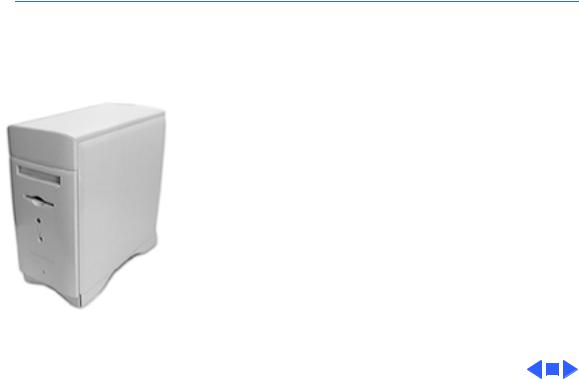
 Basics System Overview - 1
Basics System Overview - 1
System Overview
The Performa/Power Macintosh 6400 and 6500 computers combine RISC-based PowerPC performance with full multimedia features. Several features are implemented as plug-in modules available as configuration options or later upgrade, such as PCI cards, internal storage devices, and the Apple TV/FM Radio System. The modules are designed to be user installed.
User controls include the following:
• Soft power-on control from keyboard
• Front panel sound-control push buttons
• Front panel brightness-control push buttons
• Optional infrared remote control
• Voltage switch
• Subwoofer balance control

Basics |
Configurations - 2 |
|
|
|
|
|
Configurations |
|
|
Performa 6400 |
|
|
The 6400 has a PowerPC 603ev processor. Expansion |
|
|
connections on the logic board include the following: |
|
|
• DRAM DIMM expansion socket |
|
|
• Communications slot for modems and Ethernet |
|
|
• TV/FM tuner port |
|
|
• Video-in slot |
|
|
• External video port |
|
|
• Two PCI expansion slots |
|
|
• Two GeoPort serial ports |
|

Basics |
Configurations - 3 |
|
|
|
|
Power Macintosh 6400
The Power Macintosh 6400 has the same feature set as the Performa 6400. It is available with a PowerPC 603ev processor running at 180 MHz or at 200 MHz.
Performa 6410 and 6420
These computers are sold in Japan, Australia, and Europe. They both ship with 8X-speed CD-ROM drives. The 6410 has 16 MB of RAM and a 1.6 GB hard drive. The 6420 has up to 24 MB of RAM, a 2.4 GB hard drive, and a 256K level-2 cache card.

 Basics Configurations - 4
Basics Configurations - 4
Performa 6400/200 with Zip Drive
The 6400/200 with Zip drive is sold in the United States. It has the same feature set as the 6400/200, but differs with these features:
• 32 MB RAM
• 2.4 GB hard drive
• 8x CD-ROM drive
• 100 MB Zip drive

 Basics Configurations - 5
Basics Configurations - 5
Power Macintosh 6500
The Power Macintosh 6500 is similar to the Performa/Power Macintosh 6400, but differs with these features:
• Processor bus runs at 50 MHz
• DRAM expandable to 128 MB using extended data out (EDO) mode, 60 ns or faster DIMMs (no onboard RAM)
• 2 MB built-in video RAM
• Tray-loading, 12X-speed CD-ROM drive
• Zip drive option
• More monitor video modes supported
• 2D and 3D built-in hardware graphics acceleration.

Basics |
Configurations - 6 |
|
|
|
|
Power Macintosh 6500/225
The Power Macintosh 6500/225 has the 6500 feature set with a CPU running at 225 MHz and a 2 GB hard drive.
Power Macintosh 6500/250
The Power Macintosh 6500/250 has the 6500 feature set with a CPU running at 250 MHz.
A configuration of the 6500/250 sold to the education market in the Americas comes with
• 4 GB hard drive
• Ethernet

Basics |
Configurations - 7 |
|
|
|
|
|
A configuration of the 6500/250 sold to the consumer |
|
|
market in the Americas comes with |
|
|
• 4 GB hard drive |
|
|
• 24X-speed CD-ROM drive |
|
|
• 56.6K Apple/GV Modem |
|
|
• Home Software bundle |
|
|
• Mac OS 8.0 |
|
|
A configuration sold in Europe comes with |
|
|
• 4 GB hard drive |
|
|
• 24X-speed CD-ROM drive |
|
|
• Zip drive |
|
|
• 33.6 modem |
|
|
• Mac OS 8.0 |
|

Basics |
Configurations - 8 |
|
|
|
|
|
A configuration sold to the consumer market in Latin |
|
|
America comes with |
|
|
• 4 GB hard drive |
|
|
• 24X-speed CD-ROM drive |
|
|
• 33.6 modem |
|
|
• Mac OS 8.0 |
|

 Basics Configurations - 9
Basics Configurations - 9
Power Macintosh 6500/275
The Power Macintosh 6500/275 has a 603e processor running at 275 MHz and comes with
• 48 MB DRAM on the logic board
• 4 GB hard drive
• 512K L2 cache card
All other hardware features are the same as previous 6500 series computers.
A configuration sold to the education market in the Americas comes with
• 32 MB DRAM
• Zip drive
• Video in
• NTSC out
• Ethernet
• Mac OS 8.0

Basics |
Configurations - 10 |
|
|
|
|
|
A configuration of the 6500/275 sold to the consumer |
|
|
market in the Americas comes with |
|
|
• 32 MB DRAM |
|
|
• 6 GB hard drive |
|
|
• 24X-speed CD-ROM drive |
|
|
• Zip drive |
|
|
• 56.6K Apple/GV modem |
|
|
• Home Software bundle |
|
|
• Mac OS 8.0 |
|

Basics |
Configurations - 11 |
|
|
|
|
|
Another configuration of the 6500/275 sold to the |
|
|
consumer market in the Americas comes with |
|
|
• 48 MB DRAM |
|
|
• 6 GB hard drive |
|
|
• 24X CD-ROM drive |
|
|
• Zip drive |
|
|
• 56.6K Apple/GV modem |
|
|
• Microsoft Small Office software bundle |
|
|
• Mac OS 8.0 |
|
|
A configuration sold in Asia and the Pacific comes with |
|
|
• 32 MB DRAM |
|
|
• 24X-speed CD-ROM drive |
|
|
• Avid Cinema |
|
|
• Video in |
|
|
• Mac OS 8.0 |
|

 Basics Configurations - 12
Basics Configurations - 12
Power Macintosh 6500/300
The Power Macintosh 6500/300 has a 603e processor running at 300 MHz and comes with
• 64 MB DRAM on the logic board
• 4 GB hard drive
• 512K L2 cache card.
All other hardware features are the same as previous 6500 series computers.
A configuration sold to the consumer market in the Americas comes with
• 6 GB hard drive
• 24X-speed CD-ROM drive
• Zip drive
• 56.6K Apple/GV modem
• Home Software bundle
• Mac OS 8.0

Basics |
Configurations - 13 |
|
|
|
|
|
A configuration of the 6500/300 sold to the consumer |
|
|
market in Latin America comes with |
|
|
• 6 GB hard drive |
|
|
• 24X-speed CD-ROM drive |
|
|
• Zip drive |
|
|
• 33.6 modem |
|
|
• Mac OS 8.0 |
|
|
A configuration of the 6500/300 sold in Asia and the Pacific |
|
|
comes with |
|
|
• 24X-speed CD-ROM drive |
|
|
• Mac OS 8.0 |
|

Basics |
Configurations - 14 |
|||
|
|
|
||
|
A configuration sold in Europe comes with |
|||
|
• 6 GB hard drive |
|||
|
• 24X-speed CD-ROM drive |
|||
|
• TV/FM tuner |
|||
|
• Video in |
|||
|
• Avid Cinema |
|||
|
• 33.6 modem |
|||
|
• Mac OS 8.0 |
|||
|
|
|
|
|
|
|
|
|
|
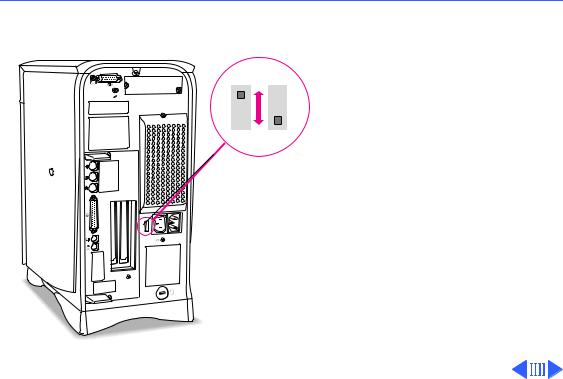
 Basics Voltage Switch - 15
Basics Voltage Switch - 15
|
|
|
|
|
Voltage Switch |
|
|
|
|
|
The voltage switch must be |
|
|
|
|
|
set correctly to avoid |
|
|
|
|
|
|
|
|
|
|
|
damaging the computer. |
|
|
|
|
|
Insert a screw driver in the |
Voltage Switch |
slot to set the switch to show |
||||
|
|
|
|
|
“115” for voltages between |
|
|
|
|
|
100 and 130. Set the switch |
|
|
|
|
|
to show “230” for voltages |
|
|
|
|
|
between 200 and 270. Some |
|
|
|
|
|
countries use two |
|
|
|
|
|
standardized voltages. If you |
|
|
|
|
|
aren’t sure which voltage is |
|
|
|
|
|
available, check with the |
|
|
|
|
|
electricity supply company |
|
|
|
|
|
before plugging in the |
|
|
|
|
|
computer. |

Basics |
Voltage Switch - 16 |
|||
|
|
|
|
|
|
Here is a table listing voltages for some countries: |
|||
|
|
|
|
|
|
Country |
Voltage |
|
|
|
|
|
|
|
|
Japan |
100 |
|
|
|
|
|
|
|
|
Algeria, Indonesia, Lebanon, Libya, Peru, S. Korea, Vietnam |
100 or 220 |
|
|
|
|
|
|
|
|
Ecuador, Jamaica, Philippines, Taiwan |
110 |
|
|
|
|
|
|
|
|
Bermuda, Canada, Puerto Rico, United States, Venezuela |
120 |
|
|
|
|
|
|
|
|
Colombia, Mexico, Saudi Arabia |
127 |
|
|
|
|
|
|
|
|
Brazil |
127 or 220 |
|
|
|
|
|
|
|
|
Hong Kong |
200 |
|
|
|
|
|
|
|
|
India, South Africa |
220-250 |
|
|
|
|
|
|
|
|
Israel, Pakistan, Singapore |
230 |
|
|
|
|
|
|
|

Basics |
Voltage Switch - 17 |
|||||
|
|
|
|
|
||
|
|
|
|
|||
|
Country |
Voltage |
|
|
||
|
|
|
|
|
|
|
|
Australia, Kuwait, Malta, New Zealand, Northern Ireland, |
240 |
|
|
|
|
|
Papua New Guinea, Oman, Qatar, United Kingdom |
|
|
|
|
|
|
|
|
|
|
|
|
|
Austria, Belgium, Denmark, Finland, France, Germany, |
220-230 |
|
|
|
|
|
Greece, Italy, Luxembourg, Netherlands, Norway, Portugal, |
|
|
|
|
|
|
Spain, Sweden, Switzerland |
|
|
|
|
|
|
|
|
|
|
|
|
|
Bahrain, Chile, China (People’s Republic), Czechoslovakia, |
220 |
|
|
|
|
|
Egypt, Greenland, Hungary, Iceland, Iran, Jordan, |
|
|
|
|
|
|
Liechtenstein, Nepal, Paraguay, Poland, Romania, United |
|
|
|
|
|
|
Arab Emirates, Russia and the Commonwealth of Independent |
|
|
|
|
|
|
States (CIS), Yemen, Yugoslavia |
|
|
|
|
|
|
|
|
|
|
|
|
|
|
|
|
|
|
|
|
|
|
|
|
|
|
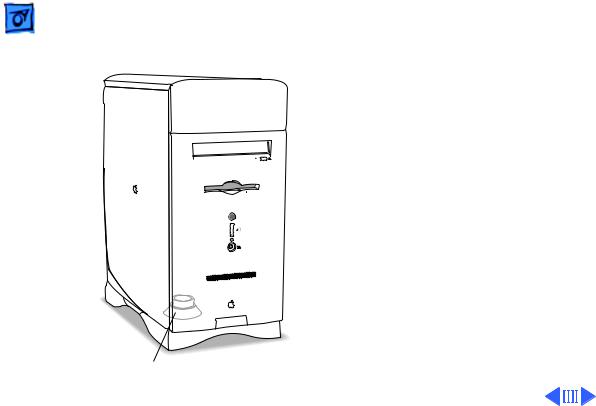
Basics |
Subwoofer Balance Control - 18 |
|
|
|
|
Subwoofer Balance Control
With external speakers attached, the subwoofer functions as a bass speaker to augment the stereo sound. Without external speakers, the subwoofer produces full-range sound instead of just bass.
Subwoofer Internal
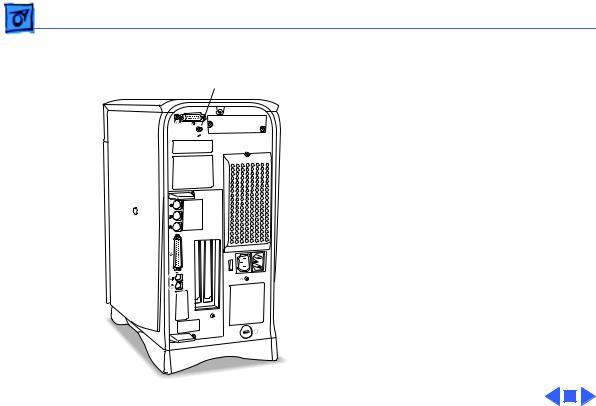
Basics |
|
Subwoofer Balance Control - 19 |
|
|
Adjust the subwoofer |
|
Subwoofer Balance Control |
balance using the subwoofer |
|
balance control. The |
|
|
|
|
|
|
subwoofer balance control |
|
|
only works with external |
|
|
speakers attached. To |
|
|
increase or decrease the |
|
|
bass coming from the |
|
|
subwoofer in relation to the |
|
|
sound coming from the |
|
|
external speakers, adjust |
|
|
the subwoofer balance |
|
|
control. |

Basics |
TV/FM Radio Tuner Card - 20 |
|
|
|
|
TV/FM Radio Tuner Card
The TV/FM radio tuner card turns the computer into a television and FM radio receiver, complete with remote control. An expansion ribbon connector for the optional TV/FM radio tuner card provides NTSC and PAL input from an external TV antenna or cable. Change channels by typing the channel number on the keyboard or with the remote control. Switch between the current and previous channel by pressing the Tab key. The computer displays the userassigned channel name on the picture in the video window.
Apple Video Player software supports the TV/FM tuner card. The user can disable channels and require a password to access the disabled channels. Users can also capture or freeze a single frame of video or record a segment of video as a QuickTime movie. It isn’t possible to resize the window while recording a movie.

Basics |
TV/FM Radio Tuner Card - 21 |
|
|
|
|
|
The TV picture is in its own window on the desktop, and the |
|
|
default size of the window is 320x240 pixels. The picture |
|
|
can be resized from 160x120 pixels up to 640x480 pixels. |
|
|
The resolution of the picture does not increase at larger |
|
|
window sizes, but the image is expanded by doubling the |
|
|
pixel size or by two-dimensional linear interpolation. |
|
|
The TV signal is carried in YUV format for improved picture |
|
|
clarity. The YUV format is 16-bit, with 8 bits for the Y |
|
|
(luminance) channel and 8 bits for the U and V |
|
|
(chrominance) channels to share by multiplexing. The |
|
|
picture is clearer because the YUV format carries more |
|
|
levels of luminance information. |
|

Basics |
TV/FM Radio Tuner Card - 22 |
|
|
|
|
|
The card is available in versions for NTSC, PAL, and SECAM |
|
|
television systems. The features of the TV tuner include the |
|
|
following: |
|
|
• Remote tuner for 181 broadcast and cable channels (U.S. |
|
|
version) |
|
|
• Coaxial connector for TV antenna or cable input (F-type |
|
|
connector in U.S. and Japanese version, IEC-type |
|
|
connector in Europe) |
|
|
• TV picture in a resizable and movable window |
|
|
• YUV format for improved clarity |
|
|
• Closed captioning and teletext support |
|
|
• Software password protection |
|
|
• Automatic and manual channel programming |
|
|
• Single remote control for TV and for playback of audio |
|
|
CDs |
|

Basics |
TV/FM Radio Tuner Card - 23 |
|||
|
|
|
||
|
The features of the FM radio tuner include the following: |
|||
|
• FM radio frequencies received and displayed |
|||
|
• Stations scanned and searched up and down the frequency |
|||
|
spectrum |
|||
|
• Step frequency |
|||
|
• DX mode to tune out harmonic spillover from other |
|||
|
stations |
|||
|
• Stereo/mono station indicator |
|||
|
• Preset station programming |
|||
|
|
|
|
|
|
|
|
|
|

Basics |
Digital Audio Video (DAV) Technology - 24 |
|
|
|
|
Digital Audio Video (DAV) Technology
The optional video input card has a separate connector called the DAV connector. The DAV connector provides access from a PCI card to the video input card by means of a 60-pin cable. This allows the PCI expansion card to use the video card to transfer real-time video data to the computer. The video card accepts video from an external source and displays it in a window on the computer’s monitor.
Note: The interface of the 60-pin DAV connector is a superset of the interface on the 34-pin DVA connector on the Power Macintosh 5200, Power Macintosh 6200, and Quadra 630 computers. An adapter cable is provided with the Performa 6400 video-in cards to connect 34-pin DVA compatible cards developed for the Power Macintosh 5200 and 6200 computers to the new 60-pin DAV connector.
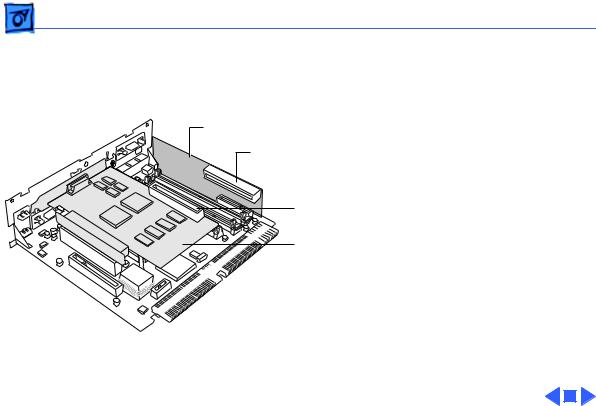
Basics |
Digital Audio Video (DAV) Technology - 25 |
||
|
|
Note: The DAV connector on |
|
|
|
the video input card |
|
|
|
provides some of the |
|
|
|
functionality of the DAV |
|
Video Input Card |
|
connectors found on the |
|
DAV Connector |
Power Macintosh 7100 and |
||
8100 models, and the |
|||
|
|
||
|
|
Macintosh Quadra AV models, |
|
DAV Connector |
but it is not compatible with |
||
any of those connectors. |
|||
|
|
||

Basics |
Sound - 26 |
|
|
|
|
Sound
The sound system supports 8-bit and 16-bit stereo sound output and input. It can create sounds digitally and play the sounds through the internal speakers or send the sound signals through the sound output jacks.
Digitizing Sound
The 6400 and 6500 computers digitize and records sound as 16-bit samples. It can use two of these sampling rates— 11k, 22k, or 44k samples per second. It can record sound from the following sources:
• Built-in microphone
• Microphone connected to the sound input jack
• Video input module
• Compact disc in the CD-ROM player

Basics |
Sound - 27 |
|
|
|
|
Sound Output
The 6400 and 6500 computers have one built-in speaker/subwoofer and two sound output jacks, one on the front and one on the back. Both output jacks are connected to the sound amplifier. Inserting a plug into either jack disconnects the internal speakers. The jack on the front is intended for headphones, and the jack on the back is intended for external speakers. The rear jack is muted when headphones are plugged in the front jack.

Basics |
Sound - 28 |
|
|
|
|
Sound Input
One sound input port for stereo sound input supports the Apple PlainTalk Microphone, and it supports non-Apple microphones. It also supports a standard stereo (miniplug- to-RCA) cable adapter for connecting stereo equipment to the computer.
Note: The sound input port does not support the Apple Omni microphone (the round microphone shipped with some earlier Macintosh models) or the attenuated RCA adapter provided with some models of Macintosh.
